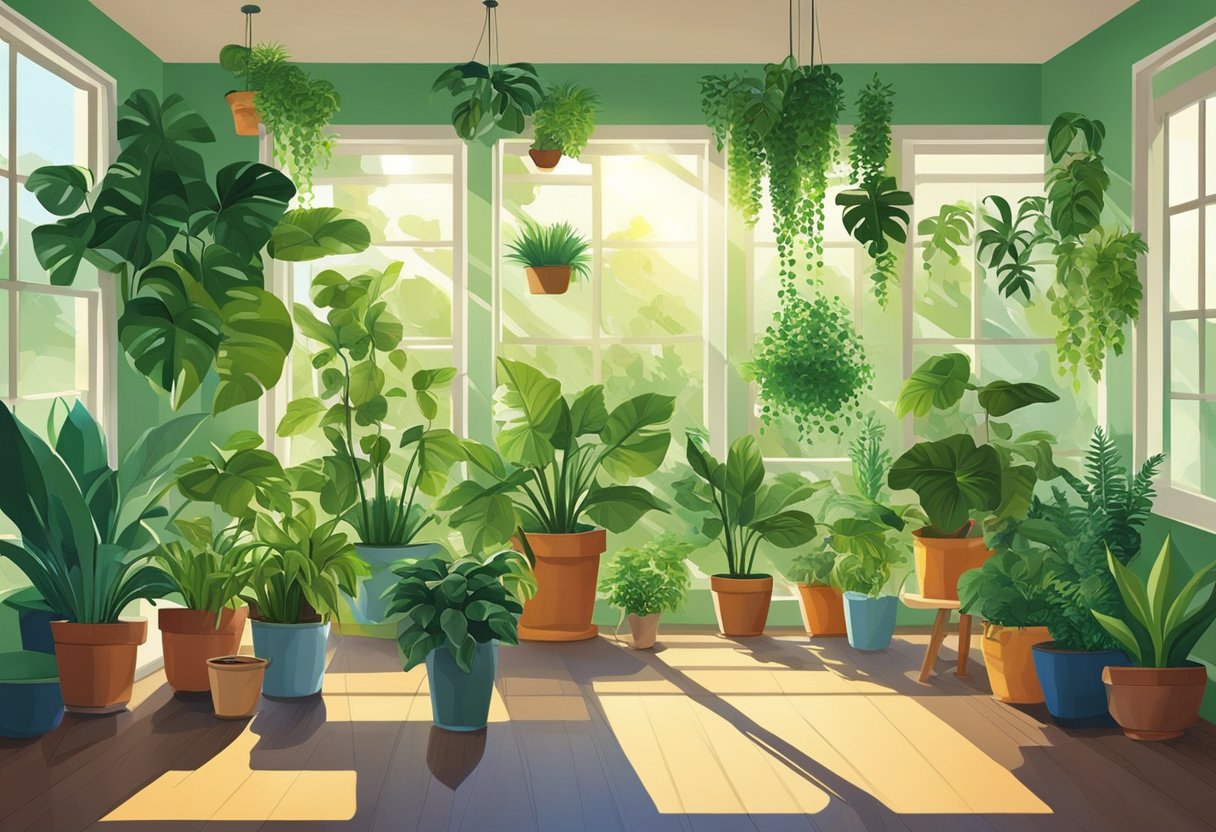Types Of Houseplants
Houseplants are a great way to bring life and color into any indoor space. Not only do they add aesthetic value, but they also have numerous benefits, such as improving air quality and reducing stress levels. There are many different types of houseplants to choose from, each with its own unique characteristics and requirements.
One of the most important factors to consider when selecting houseplants is their light requirements. Some plants thrive in bright, direct sunlight, while others prefer indirect or low light conditions. It’s important to choose plants that are well-suited to the lighting conditions in your home, as this will help ensure their health and longevity.
Caring for houseplants can be a rewarding and enjoyable experience, but it’s important to understand their individual needs in order to keep them healthy and thriving. Factors such as watering, fertilizing, and pruning can all play a role in a plant’s overall health. By taking the time to learn about the specific care requirements of your houseplants, you can help ensure their success and enjoy their beauty for years to come.
Key Takeaways
- There are many different types of houseplants to choose from, each with its own unique characteristics and requirements.
- Light requirements are an important factor to consider when selecting houseplants.
- Caring for houseplants involves understanding their individual needs and providing proper care to ensure their health and longevity.
Types of Houseplants

Houseplants are a great way to add some greenery and life to your indoor space. They come in a variety of shapes, sizes, and colors, making it easy to find one that suits your style and preferences. Here are some of the most common types of houseplants:
Foliage Houseplants
Foliage houseplants are known for their beautiful leaves, which come in a variety of shapes, sizes, and colors. Some popular foliage houseplants include the peace lily, philodendron, monstera deliciosa, ivy, croton, Chinese evergreen, and alocasia. These plants are perfect for adding some color and texture to your indoor space.
Flowering Houseplants
Flowering houseplants are known for their beautiful blooms, which come in a variety of colors and shapes. Some popular flowering houseplants include the orchid, African violet, bromeliad, and anthurium. These plants are perfect for adding some color and fragrance to your indoor space.
Succulents and Cacti
Succulents and cacti are known for their unique shapes and textures, as well as their ability to store water in their leaves and stems. Some popular succulents and cacti include the jade plant, Christmas cactus, senecio, and various types of cacti. These plants are perfect for adding some desert vibes to your indoor space.
Air Purifying Plants
Air purifying plants are known for their ability to filter toxins and pollutants from the air, making them a great choice for those who suffer from allergies or respiratory problems. Some popular air purifying plants include the spider plant, snake plant, dracaena, and ZZ plant.
Low Maintenance Plants
Low maintenance plants are perfect for those who don’t have a lot of time or energy to devote to caring for their houseplants. Some popular low maintenance plants include the rubber plant, succulent, aloe, peace lily, snake plant, and ZZ plant. These plants require minimal care and are easy to care for.
Overall, there are many different types of houseplants to choose from, each with its own unique characteristics and benefits. Whether you’re looking for a plant to add some color and texture to your indoor space, or a plant to help purify the air, there’s sure to be a houseplant that’s perfect for you.
Light Requirements for Houseplants
When it comes to houseplants, light is an essential factor that affects their growth and overall health. Different plants have varying light requirements, and it is crucial to understand them to ensure that your plants thrive. In this section, we will discuss the different light requirements of houseplants and which plants are best suited for different lighting conditions.
Low Light Conditions
Plants that thrive in low light conditions are perfect for areas with little to no natural light. These plants are best suited for rooms with north-facing windows or rooms that are far from windows. Some examples of plants that can thrive in low light conditions include snake plants, peace lilies, and philodendrons.
Bright Light Preferences
Bright light is essential for plants that require a lot of energy to grow. These plants need direct sunlight for several hours a day and are perfect for rooms with south-facing windows. Some examples of plants that prefer bright light include aloe vera, jade plants, and cacti.
Indirect Light Lovers
Indirect light is perfect for plants that require bright light but cannot tolerate direct sunlight. These plants are best suited for rooms with east or west-facing windows or rooms that receive filtered light. Some examples of plants that thrive in indirect light include monstera, fiddle leaf fig, and Chinese money plants.
In summary, understanding the light requirements of houseplants is crucial to ensure that they thrive. Whether you have a brightly lit room or a dimly lit one, there is a houseplant that can thrive in your space. By selecting the right plants for your lighting conditions, you can enjoy the beauty and benefits of indoor plants for years to come.
Caring for Your Houseplants
Caring for houseplants can be a rewarding experience, but it requires some effort and attention to detail. Here are some tips to keep your plants healthy and thriving.
Watering and Humidity
Watering is one of the most important aspects of caring for houseplants. Most houseplants prefer weekly watering, but the frequency may vary depending on the type of plant, the size of the pot, and the humidity level in your home. It is important to avoid overwatering, as this can lead to root rot and other problems. To determine if your plant needs water, stick your finger into the soil to a depth of about an inch. If the soil feels dry, it’s time to water.
Humidity is also important for many houseplants, especially those that are native to tropical regions. If your home is dry, you may need to increase the humidity around your plants by misting them with water or using a humidifier. Alternatively, you can group your plants together to create a mini greenhouse effect.
Potting and Repotting
Choosing the right potting mix and pot size is crucial to the health of your houseplants. Most houseplants prefer well-draining soil that allows water to pass through easily. When repotting, it is important to choose a pot that is slightly larger than the current one to allow room for growth. Repotting should be done every 1-2 years, or when the plant has outgrown its current pot.
Common Issues and Solutions
Houseplants can be susceptible to a variety of issues, including pests, disease, and environmental stress. Some common issues and their solutions include:
-
Pests: Common houseplant pests include spider mites, mealybugs, and scale insects. To prevent infestations, keep your plants clean and free from dust. If you do notice pests, treat them with an insecticidal soap or neem oil.
-
Disease: Overwatering and poor air circulation can lead to fungal diseases such as root rot and powdery mildew. To prevent these issues, make sure your plants are not sitting in water and provide adequate air circulation.
-
Environmental stress: Houseplants can be sensitive to fluctuating temperatures, drafts, and dry air. To prevent stress, keep your plants away from windows and doors, and avoid placing them near heating or cooling vents.
In addition to these issues, it is important to note that some houseplants can be toxic to pets. If you have pets, make sure to research the toxicity of your plants before bringing them into your home.
Selecting Houseplants for Different Environments
When it comes to selecting houseplants, there are a few things to consider, such as the environment they will be in. Different environments require different types of houseplants. Here are some suggestions for selecting houseplants for different environments.
Houseplants for Beginners
For those who are new to gardening or don’t have a lot of experience with houseplants, there are a few easy-to-care-for options that are perfect for beginners. Some of the best options for beginners include the peace lily, spider plant, and snake plant. These plants are all low maintenance and easy to grow, making them perfect for those who are just starting out.
Houseplants for Offices
If you’re looking for houseplants to brighten up your office space, there are a few things to keep in mind. First, you’ll want to choose plants that can thrive in low light conditions. Some great options for offices include the snake plant, ZZ plant, and pothos. These plants are all easy to care for and can add a touch of green to any workspace.
Houseplants for Varied Aesthetics
If you’re looking for houseplants that can create a tropical feel in your home, there are plenty of options to choose from. Some great options for creating a tropical feel include the areca palm, monstera deliciosa, and philodendron. These plants all have large, lush leaves that can make any space feel like a tropical paradise.
If you’re looking for something a little more unusual, there are plenty of options to choose from as well. Some great options for unusual plants include the air plant, string of pearls, and bird’s nest fern. These plants can add a unique touch to any space and are sure to be a conversation starter.
For those who are looking for large plants, there are plenty of options to choose from as well. Some great options for large plants include the fiddle leaf fig, rubber plant, and Swiss cheese plant. These plants can make a big statement in any room and are sure to impress.
Finally, if you’re looking for hanging plants, there are plenty of options to choose from as well. Some great options for hanging plants include the spider plant, string of hearts, and English ivy. These plants can add a touch of green to any space and are perfect for those who are short on floor space.






